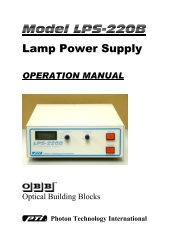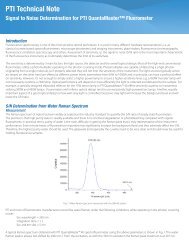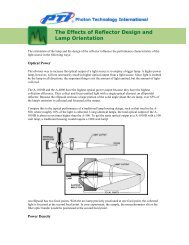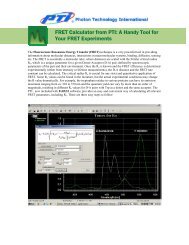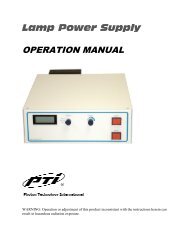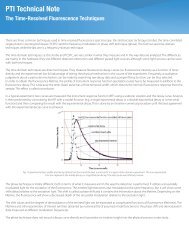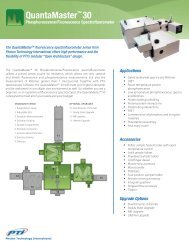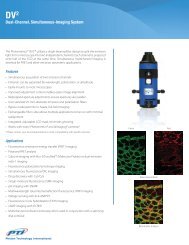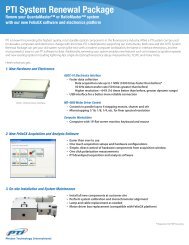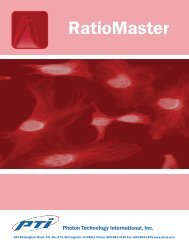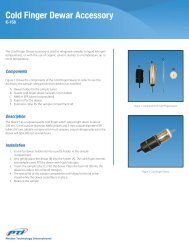The Time-Resolved Fluorescence Techniques - Photon Technology ...
The Time-Resolved Fluorescence Techniques - Photon Technology ...
The Time-Resolved Fluorescence Techniques - Photon Technology ...
Create successful ePaper yourself
Turn your PDF publications into a flip-book with our unique Google optimized e-Paper software.
<strong>The</strong> <strong>Time</strong>-<strong>Resolved</strong> <strong>Fluorescence</strong> <strong>Techniques</strong><br />
<strong>The</strong>re are three common techniques used in time-resolved fluorescence spectroscopy: the stroboscopic<br />
technique (strobe), the time-correlated single photon counting technique (TCSPC) and the frequency<br />
modulation or phase shift technique (phase). <strong>The</strong> first two are time-domain techniques while the last one is a<br />
frequency-domain technique.<br />
<strong>The</strong> time-domain techniques, i.e. the strobe and TCSPC, are very similar in what they measure and in the way<br />
data are analyzed. <strong>The</strong> differences are mainly in the hardware, they use different detection electronics and<br />
different pulsed light sources, although some light sources can be used with both techniques.<br />
<strong>The</strong> time-domain techniques are direct techniques. <strong>The</strong>y measure fluorescence decay curves (i.e. fluorescence<br />
intensity as a function of time) directly and the experimenter has full advantage of seeing the physical<br />
mechanism in the course of the experiment. Frequently, a qualitative judgement about a particular mechanism<br />
can be made by examining raw decay data and a proper fitting function can be thus selected.<br />
In order to obtain the fluorescence lifetime, the profile of instrument response function (excitation pulse) has<br />
to be measured in addition to the fluorescence decay. This is because the lamp (laser) pulse has a finite temporal<br />
width, which distorts the intrinsic fluorescence response from the sample. This effect is called convolution.<br />
In a typical experiment, two curves are measured: the instrument response function (IRF) using a scatterer<br />
solution and the decay curve. Analysis is then performed by convoluting the IRF with a model function (e.g. a<br />
single exponential decay or a double exponential decay or some other function) and then comparing the result<br />
with the experimental decay. This is done by an iterative numerical procedure until the best agreement with the<br />
experimental decay curve is achieved.
Fig. 7 Experimental laser profile and decay (dotted functions) and the best numerical fit in a typical timedomain<br />
experiment. <strong>The</strong> true exponential function represents the model decay, i.e. a hypothetical decay if the<br />
laser pulse was infinitely narrow.<br />
<strong>The</strong> phase technique is totally different, both in terms of what it measures and in the way the detection is<br />
performed. It utilizes a sinusoidally modulated light for the excitation of the fluorescence. <strong>The</strong> emitted light<br />
becomes also modulated at the same frequency, but it will show some shift (delay) relative to the excitation<br />
light. This shift is called a phase shift and it contains the information about the lifetime. Depending on the<br />
lifetime, the fluorescence will show a decreased depth of the sinusoidal modulation relative to the excitation<br />
light.<br />
<strong>The</strong> shift values and the degree of demodulation of the emitted light can be expressed as complicated functions<br />
of fluorescence lifetime(s). <strong>The</strong> lifetimes and other parameters of interest are then obtained by numerical fits of<br />
assumed model functions to the phase shift and demodulation data measured at different modulation<br />
frequencies.<br />
<strong>The</strong> phase technique does not record a decay curve directly and it provides no intuitive insight into the<br />
physical process under study.<br />
<strong>The</strong> Stroboscopic Technique (Strobe)<br />
This is the most recent and electronically the simplest technique. It utilizes a pulsed light source (a nanosecond<br />
flash lamp or a laser) and measures fluorescence intensity at different time delays after the pulse. As a result, a<br />
fluorescence decay curve is collected. <strong>The</strong> diagram below shows the basic elements of a strobe instrument that<br />
utilizes a nanosecond flashlamp.<br />
Fig. 8 Block diagram of a NanoFlash-based stroboscopic system<br />
A master clock (oscillator) generates pulses at a fixed (18-20 kHz) frequency. <strong>The</strong> pulses are routed<br />
simultaneously to the flash lamp trigger circuit and a digital delay gate generator (DGG) unit.<br />
On the lamp side, the oscillator pulse triggers (via pulse generator) a thyratron-gated flashlamp and the lamp<br />
flashes, excites a sample, which subsequently emits fluorescence. At the same time a pulse synchronized with<br />
the lamp pulse triggers the DGG, which outputs a delayed TTL pulse.<br />
<strong>The</strong> DDG is under computer control and the value of the TTL pulse delay is determined in the acquisition<br />
software. <strong>The</strong> delayed pulse triggers an avalanche circuit, which provides a high voltage pulse (ca. 1000V) for<br />
the detection circuitry. This pulse creates the gain and the temporal discrimination gate for the photomultiplier.
An important feature is that the strobe technique does not use a conventional voltage divider network for<br />
providing inter-dynode voltages in the photomultiplier (PMT). Instead, the PMT dynodes are interconnected by<br />
a stripline circuit. <strong>The</strong> pulse from the avalanche is injected in the stripline at the time delay specified by the<br />
DGG. <strong>The</strong> pulse travels along the dynode chain amplifying the primary photoelectrons generated at the<br />
specific time delay. This way high amplification and time gating are simultaneously achieved in the PMT<br />
strobe circuit. <strong>The</strong> measured analog signal is fed to a 12-bit A/D converter. Scanning the gate (time delay)<br />
across the fluorescence decay allows the acquisition of fluorescence intensity as a function of time.<br />
One of the advantages of the stroboscopic technique is the ability to utilize low frequency lasers (e.g. nitrogen<br />
laser), which are relatively inexpensive and at same time provide very high-energy pulses and can pump dye<br />
lasers thus resulting in excellent excitation wavelength coverage.<br />
<strong>The</strong> principle of operation of the LaserStrobe system, based on PTI nitrogen and dye lasers, is outlined in Fig.<br />
9. <strong>The</strong> differences in the electronics between the laser- and flash lamp systems are due to the fact that the laser<br />
operates at much lower repetition rates (up to 20 Hz) than the flash-lamp (18 kHz). While the flash lamp firing<br />
is controlled by the oscillator, the firing of the laser is controlled by the software/interface. <strong>The</strong> laser also has an<br />
inherent jitter (i.e. the uncertainty between the time it’s triggered and the time it actually fires), therefore a<br />
photodiode (Pd) is placed in front of the laser to provide a precise timing for the DGG trigger.<br />
Fig. 9 Block diagram of an N2/Dye Laser-based stroboscopic system<br />
<strong>The</strong> strobe technique can also be very fast; this is because it measures fluorescence intensity directly and,<br />
unlike photon counting techniques, is not limited by photon counting statistic and can therefore take advantage<br />
of high intensity fluorescence.<br />
A unique feature of the strobe is the ability to measure decays with the use of non-linear timescale. This is<br />
possible because the software controls the delayed output of the DGG. <strong>The</strong> stroboscopic instruments employ<br />
arithmetic progression and logarithmic timescale acquisition protocols in addition to the conventional linear<br />
timescale. <strong>The</strong>se non-linear timescale protocols enhance the lifetime resolving power and allow for the<br />
acquisition of complex decays with underlying lifetimes differing by orders of magnitude using fewer data<br />
points than would be required with the linear timescale.<br />
<strong>Time</strong>-Correlated Single <strong>Photon</strong> Counting (TCSPC)
<strong>The</strong> TCSPC is also the time-domain technique. Like the strobe, it utilizes pulsed light sources (flash lamps,<br />
lasers). It also measures the same experimental functions as strobe, i.e. the fluorescence decay and the IRF;<br />
however, its detection is based on a different principle.<br />
<strong>The</strong> block diagram shows the principle of TCSPC operation. <strong>The</strong> clock triggers the lamp; the lamp fires and a<br />
photodiode (Pd) in front of the lamp triggers the electronics (“start” pulse).<br />
Fig. 10 Block diagram of a TCSPC system<br />
<strong>The</strong> start pulse is “cleaned” by the leading edge (LE) discriminator and it starts the time-to-amplitude<br />
converter (TAC). <strong>The</strong> TAC is the key element of the technique. After being triggered, the TAC creates a<br />
voltage ramp, which is linear in time (e.g. it starts charging a capacitor).<br />
In the mean time, the sample has been excited and emitted fluorescence photons. When the PMT detects a<br />
photon, a short pulse is created at the output of the PMT. <strong>The</strong> pulse is “cleaned” by the constant fraction<br />
(CF) discriminator and enters the TAC as a “stop” pulse. Once the stop pulse (i.e. the first arriving photon)<br />
has been detected, the voltage ramp is stopped and the voltage value (equivalent to the time difference between<br />
the start and stop pulses) is transmitted to the multichannel analyzer, which increments the counts in the<br />
channel corresponding to the detected voltage (time). This process is repeated with each flash and eventually,<br />
after many cycles, a histogram of counts vs. the channel number (time) is created. If certain conditions are met,<br />
the histogram represents the fluorescence intensity as a function of time, i.e. the fluorescence decay.<br />
<strong>The</strong> main condition is that the probability of the second photon occurring after the start pulse should be<br />
negligible. This implies that no more than one photon per about fifty flashes is detected, i.e. the duty cycle of<br />
the detection is very low. This is a limitation especially for strong emitting samples, as the technique cannot<br />
take advantage of the inherent high intensity in those samples. This is not an impediment for very week samples<br />
and, in fact, this is where the technique excels, as it truly detects single photons.<br />
An important feature is that the single photon counting obeys the Poisson statistics. Because of that, the<br />
standard deviation of each data point is well determined, i.e. σ = N 1/2 , where N is the number of counts. This<br />
makes the data precision very predictable and facilitates the analysis process, where the knowledge of standard<br />
deviations is required.
As in the strobe technique, the analysis requires in most cases that the decay and the IRF be collected. <strong>The</strong><br />
model parameters (e.g. lifetimes and pre-exponential factors) are recovered from the non-linear least squares<br />
fitting procedure that involves iterative re-convolution of the IRF and model function.<br />
<strong>The</strong> low photon count relative to the lamp frequency requirement means that only high-frequency light sources<br />
should be used. This eliminates some powerful and spectrally versatile sources like a nitrogen laser pumping<br />
a dye laser. Typically, nanosecond flash lamps and mode-locked lasers are used, the latter being quite<br />
expensive and often troublesome to maintain. Recently, solid-state diode lasers are becoming popular. <strong>The</strong>ir<br />
advantages are high repetition frequencies, short pulses and low cost. <strong>The</strong>ir main disadvantage is the available<br />
wavelength range, which is limited to visible and near IR.<br />
<strong>The</strong> TAC is a linear device, so the technique can only work with equal time increments. That means that a<br />
large number of channels (data points) are needed to adequately record fluorescence decays with very short and<br />
very long lifetimes present.<br />
<strong>The</strong> Phase Shift Technique<br />
This is the oldest of all lifetime techniques. Unlike the pulse methods, the phase shift technique employs a<br />
continuous light source (e.g. xenon arc lamp) whose intensity is sinusoidally modulated at a frequency ω.<br />
<strong>The</strong> fluorescence response can be determined by convoluting the excitation function with the intrinsic decay<br />
law (e.g. a single exponential function). <strong>The</strong> resulting fluorescence response will also be modulated at the<br />
frequency ω, but it will exhibit a phase shift Φ and a reduced depth of modulation as compared with the<br />
excitation light (see diagram). If the underlying fluorescence decay is single exponential, the lifetime τ can be<br />
easily and quickly determined from the phase shift Φ and degree of modulation m: τ = tan (Φ)/ω and<br />
m=(1+ω 2 τ 2 ) -1/2 , where m=(B/A)/(b/a).<br />
However, with a single modulation frequency, only a single lifetime can be determined. In order to analyze<br />
complex fluorescence decays, the shift and the modulation depth should be measured with a large range of<br />
modulation frequencies. <strong>The</strong> frequency response of the shift and modulation is then subjected to the non-linear<br />
least squares fitting procedure, from which the model parameters (lifetimes, pre-exponential factors) are<br />
recovered.<br />
Fig. 11 Illustration of the phase shift and change in the modulation depth of the emitted light relative to the<br />
excitation light
For typical lifetimes in the range of hundreds of picoseconds to hundreds of nanoseconds megahertz<br />
frequencies are used. <strong>The</strong>se are usually obtained with electrooptical (EO) modulators and the upper limit is<br />
currently 350MHz in commercial systems based on arc lamps. One problem is a significant intensity loss<br />
when conventional light sources (lamps) are used due to a narrow range of acceptance angles for such<br />
modulators.<br />
EO modulators are special crystals that rotate polarized light when a certain voltage is applied. <strong>The</strong> modulator is<br />
placed between a pair of crossed polarizers, so no light is transmitted in the absence of voltage. In order to<br />
transmit light quite high voltages (1-7kV) should be applied. However, at MHz frequencies that are needed for<br />
the light modulation, only voltages of about 100V can be achieved. This causes low depth of modulation and<br />
poor light transmittance.<br />
Another major disadvantage of EO modulators is that they require collimated light. With arc lamps the light<br />
transmittance is less then 5% and this is before any monochromators or filters!<br />
<strong>The</strong> phase shift instrumentation becomes much more complex when the picosecond lifetime range is required.<br />
In order to obtain gigahertz frequencies, higher harmonics of mode-locked picoseconds lasers are used and also<br />
faster multi-channel plates (MCP) replace conventional photomultipliers. <strong>The</strong> cost of such systems grows<br />
enormously! <strong>The</strong> so-called cross-correlation technique has been developed to facilitate signal detection at high<br />
frequencies. In this technique the light source and the detector are modulated at somewhat different frequencies.<br />
This results in an additional signal at the much lower difference frequency, which contains the phase and<br />
modulation information of the original signal.<br />
United States: 300 Birmingham Road, P.O. Box 272 Birmingham NJ 08011 Phone: 609-894-4420 Fax: 609-894-1579<br />
Canada: 347 Consortium Court, London, Ontario, N6E 2S8 Phone: (519) 668-6920 Fax: (519) 668-8437<br />
United Kingdom: Unit M1,Rudford Ind’l Est.,Ford Rd,Ford,West Sussex Bn18 0BF Phone:+44 (0) 1903 719 555 Fax:+44 (0) 1903 725 772<br />
Germany: PhotoMed GmbH, Buero Sued, Inninger Str. 1, 82229 Seefeld Phone: +49-8152-993090 Fax: +49-8152-993098<br />
Denmark: PhotoMed GmbH, Sondre Alle, DK-4600 Koge Phone: +45 56 66 33 86 Fax: +45 56 66 33 81<br />
VIST US ONLINE AT WWW.PTI-NJ.COM<br />
Copyright© 2005 <strong>Photon</strong> <strong>Technology</strong> International, Inc. All Rights Reserved. PTI is a registered trademark of <strong>Photon</strong> <strong>Technology</strong><br />
International, Inc. Specifications are subject to change without notice. Rev. A



